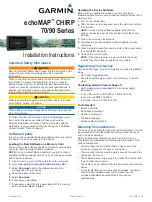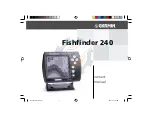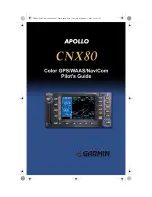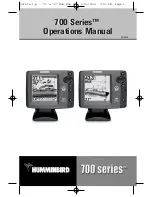
Bail Mounting the Device
NOTICE
If you are mounting the bracket on fiberglass with screws, it is
recommended to use a countersink bit to drill a clearance
counterbore through only the top gel-coat layer. This will help to
avoid any cracking in the gel-coat layer when the screws are
tightened.
Stainless-steel screws may bind when screwed into fiberglass
and overtightened. Garmin recommends applying an anti-seize
lubricant to the screws before installing them.
1
Select the mounting hardware appropriate for your mounting
surface and for the bail-mount bracket.
2
Using the bail-mount bracket as a template, mark the pilot
holes through the screw holes.
3
Using a drill bit appropriate for the mounting hardware, drill
the four pilot holes.
4
Using the selected mounting hardware, secure the bail-mount
bracket to the mounting surface.
5
Install the bail-mount knobs
À
on the sides of the device.
6
Place the device into the cradle
Á
.
7
Place the cradle in the bail-mount bracket and tighten the
bail-mount knobs.
Flush Mounting the Device
NOTICE
Be careful when cutting the hole to flush mount the device.
There is only a small amount of clearance between the case and
the mounting holes, and cutting the hole too large could
compromise the stability of the device after it is mounted.
Using a metal pry tool such as a screwdriver can damage the
trim caps and the device. Use a plastic pry tool when possible.
You can mount the device in your dashboard using the flush-
mount template and appropriate hardware.
1
Trim the template and make sure it fits in the location where
you want to mount the device.
2
Secure the template to the mounting location.
3
Using a 9.5 mm (
3
/
8
in.) drill bit, drill one or more of the holes
inside the corners of the solid line on the template to prepare
the mounting surface for cutting.
4
Using a jigsaw or rotary cutting tool, cut the mounting surface
along the inside of the solid line indicated on the template.
5
Place the device into the cutout to test the fit.
6
If necessary, use a file and sandpaper to refine the size of
the hole.
7
If your device has trim caps, use a pry tool, such as a flat
piece of plastic or a screwdriver, to carefully pry up the
corners of the trim caps
À
, slide the pry tool to the center
Á
,
and remove the trim caps.
8
Ensure the mounting holes on the device line up with the pilot
holes on the template.
9
If the mounting holes on the device do not line up with the
pilot holes on the template, mark the new pilot-hole locations
on your template.
10
Using a 3.2 mm (
1
/
8
in.) drill bit, drill the pilot holes.
11
Remove the template from the mounting surface.
12
If you will not have access to the back of the device after you
mount it, connect all necessary cables to the device before
placing it into the cutout.
NOTE:
To prevent corrosion of the metal contacts, cover
unused connectors with weather caps.
13
Install the rubber gasket pieces on the back of the device.
The pieces of the rubber gasket have adhesive on the back.
Make sure you remove the protective liner before installing
them on the device.
14
Securely connect each cable to a port on the cradle.
15
Place the device into the cutout.
16
Secure the device to the mounting surface using the included
screws.
17
Install the trim caps by snapping them in place around the
edges of the device.
Installing the Cables and Connectors
Wiring to Power
1
Route the power cable from the swivel mount to the boat
battery or fuse block.
2










